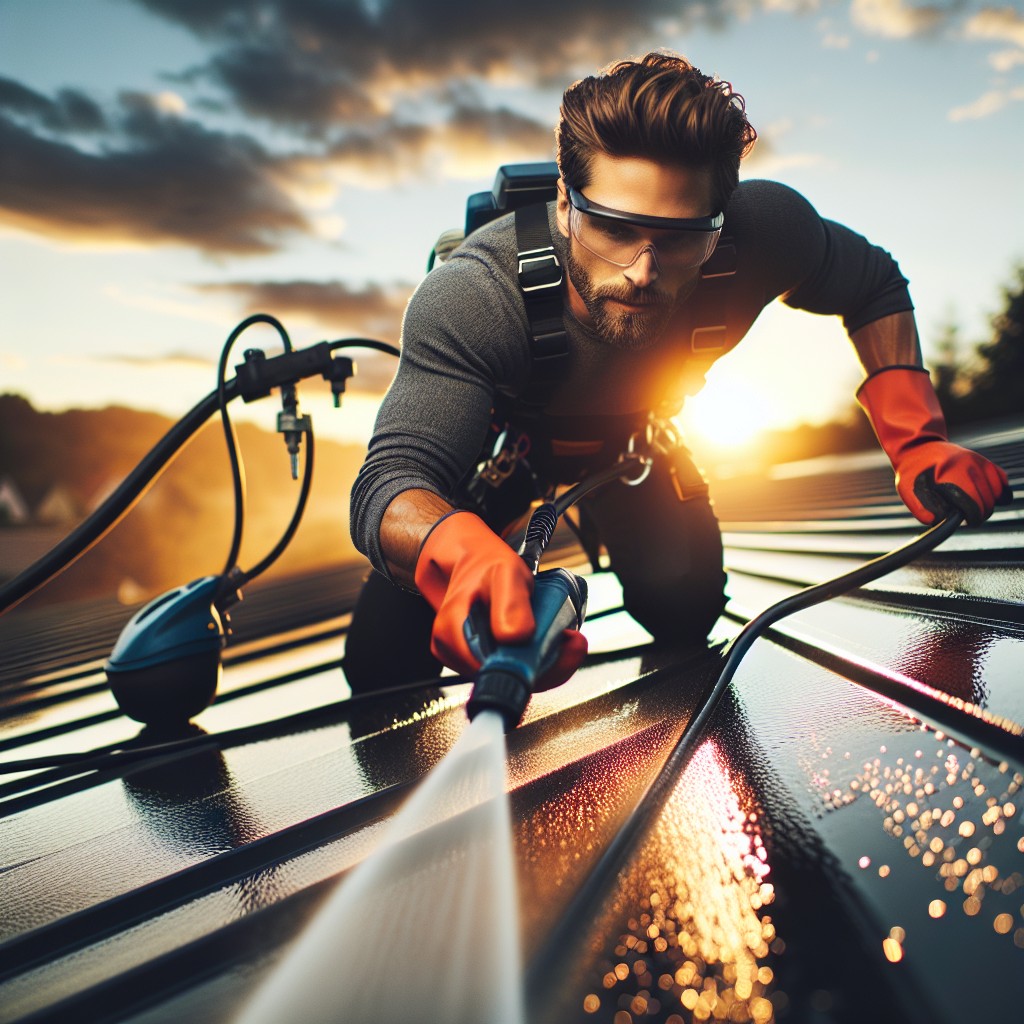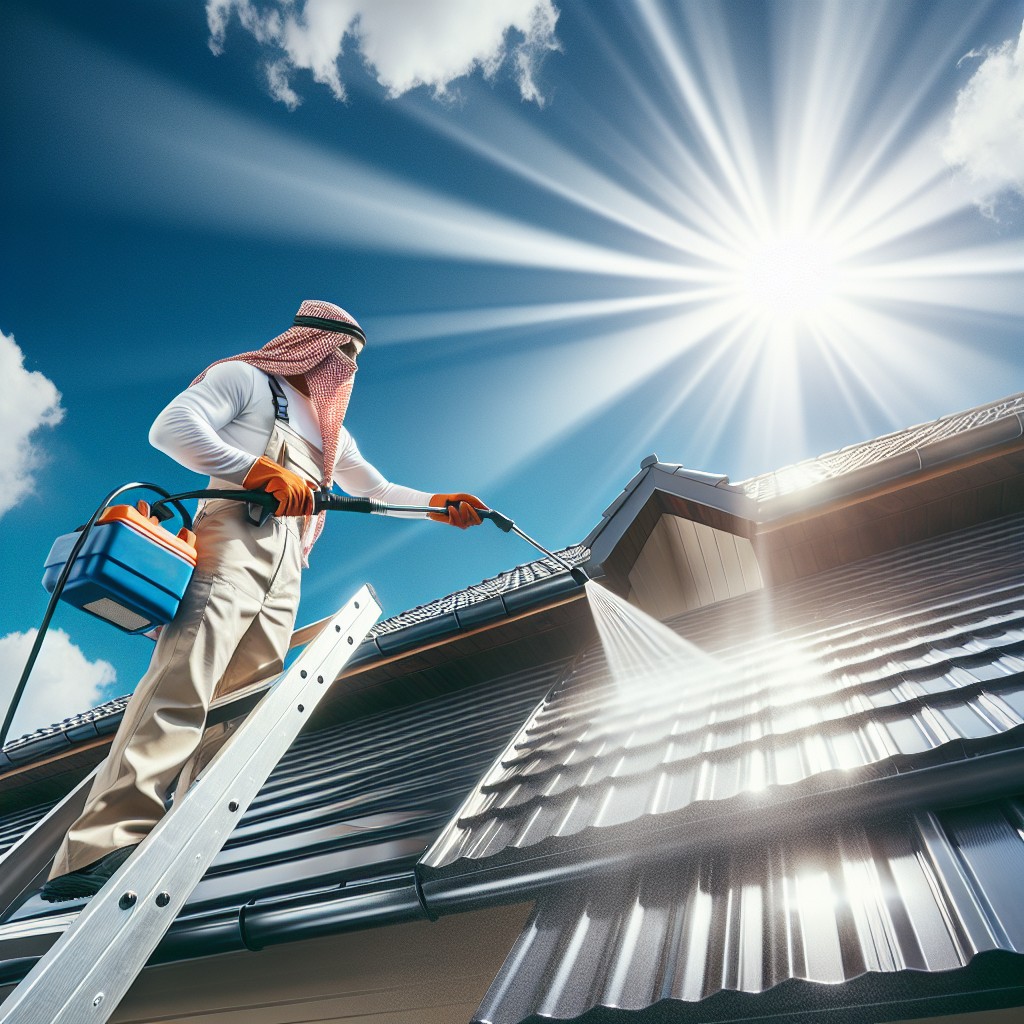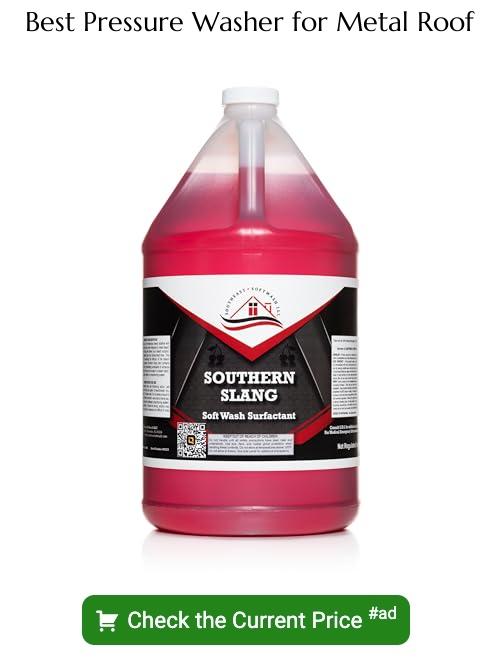Last updated on
Get the most out of your metal roof without compromising its integrity by pressure washing, because it’s an effective, non-destructive method of cleaning and maintenance.
Key takeaways:
- Safety precautions for pressure washing a metal roof
- Use low-pressure setting to prevent damage to the roof
- Selecting the right pressure washer and cleaning solution
- When to clean a metal roof and special cleaning circumstances
- When to call professionals for help and how to protect yourself
Safety First

Before embarking on any roof maintenance task, prioritizing safety is paramount. Always wear non-slip shoes to maintain footing on the slick metal surface. Eye protection is crucial to shield from debris dislodged during pressure washing. Use a securely fastened safety harness, especially on high or steeply sloped roofs. Ensure that the ladder used for access is stable and appropriately positioned.
It’s also important to be mindful of power lines and to keep the pressure washer’s wand and water stream at a safe distance. Notify others of your work to keep the area below clear, preventing injury from falling objects. Remember, if weather conditions worsen, it’s best to postpone the task to avoid unnecessary risks.
Can You Pressure Wash a Metal Roof?

Pressure washing is a suitable method for cleaning metal roofs due to their durability and resistance to water damage. However, it is critical to use a low-pressure setting to avoid damaging the roof’s protective coatings or paint. High-pressure streams can penetrate seams, flashing, or cause erosion of the coating which protects the metal from corrosion.
When using a pressure washer, keep the nozzle at least 12 inches away from the surface and use a wide fan setting to disperse water pressure. Consistent sweeping motions help to avoid focusing the jet on one area for too long, thereby preventing denting or warping of the metal panels.
Additionally, the angle of the spray is important; it’s best to direct the water flow parallel to the roof panels, not against them, which could force water under the panels. Regular cleaning with the correct pressure settings will remove dirt, debris, and mildew, maintaining the longevity and aesthetic appeal of the metal roof.
Using the Right Pressure Washer
Selecting an appropriate pressure washer is crucial for effectively cleaning your metal roof without causing damage. Opt for a washer with a psi (pounds per square inch) rating between 1200 to 2000 – this range is strong enough to remove dirt and mildew but gentle enough to prevent harm to the roof’s protective coatings.
Adjustable nozzles are advantageous as they allow modification of the water stream to suit different phases of the cleaning process; use a broader, less concentrated spray to avoid denting or warping the metal. Equipment with a maximum temperature setting can also be useful as hot water can aid in breaking down grime more efficiently. Remember, the key is to use minimal pressure necessary to clean the surface to avoid forcing water underneath the panels.
Best Metal Roof Cleaning Solution
Selecting the appropriate cleaning solution is crucial for maintaining the integrity of your metal roof while effectively removing dirt, algae, and mildew. A mixture of mild dish soap and water can serve as an effective base solution for general cleaning needs.
For tougher grime, adding a cup of non-abrasive, environmentally-friendly cleaner to a gallon of water can enhance cleaning power. Avoid bleach and harsh chemicals, as they can damage the metal’s coating and lead to corrosion.
For a more natural approach, consider a solution of vinegar and water, which can help remove stubborn stains without the use of toxic chemicals. Always test your chosen solution on a small, inconspicuous area to ensure it does not harm the roof’s finish.
When to Clean a Metal Roof
Regular maintenance is key to preserving the integrity and appearance of your metal roof. Ideally, aim to clean it once a year, but there are a few other occasions when a wash may be necessary:
- After a severe storm or wind event that can deposit debris and dirt.
- When noticing stains from leaves, sap, or bird droppings, which can become corrosive if left unattended.
- In the presence of algae, mold, or mildew growth, which thrive in damp, shaded areas and can lead to cosmetic and structural damage over time.
- If you detect a dullness or change in color that suggests a layer of grime is affecting the roof’s reflective capabilities, which can impact energy efficiency.
- Before conducting any paintwork or applying a protective coating to ensure proper adhesion.
Adjust the cleaning schedule according to your local environment; roofs in coastal areas or places with high pollution may require more frequent attention.
How to Clean a Painted Metal Roof
Begin by ensuring that the painted metal surface is cool to the touch; ideally start in the early morning or late afternoon to avoid the heat of the day, which can cause rapid drying and uneven cleaning.
Use a pressure washer set to a low pressure of no more than 1500 PSI to prevent damaging the paint. Attach a wide-angle tip to distribute water pressure over a greater area, further protecting the paint finish.
Start washing from the top of the roof and work your way down, maintaining a consistent distance of at least 12 inches from the surface to avoid concentrated pressure. Move in smooth, overlapping strokes to cover the area efficiently.
If stubborn stains persist, apply a gentle cleaning solution recommended for painted metal roofs, using a soft brush or cloth for application.
Rinse thoroughly with plain water at a low pressure to remove any residue, ensuring the cleaner does not dry on the roof’s surface. This method preserves the integrity of the painted surface while effectively removing debris and dirt build-up.
Regular cleaning of a painted metal roof not only enhances its appearance but also extends its lifespan by preventing the accumulation of potentially corrosive substances.
Special Metal Roof Cleaning Circumstances
Certain conditions require tailored approaches when cleaning metal roofs:
1. Overhanging Trees: These can deposit sap and debris on the surface, necessitating a gentler pre-washing process to avoid scratching the metal.
2. Nearby Manufacturing Plants: Emissions can leave acidic residues that demand neutral, pH-balanced cleaning solutions to prevent corrosion.
3. Heavy Snowfall Regions: Melting snow can lead to ice dams, requiring a seasonal cleaning strategy post-thaw to remove trapped dirt and prevent rust.
4. Coastal Homes: Salt spray can accelerate corrosion. More frequent rinsing with fresh water can help mitigate this effect.
5. Aged or Damaged Roofs: If your metal roof shows signs of aging or damage, high-pressure washing might exacerbate issues. Instead, opt for a soft wash method to prevent harming the protective coatings.
Each of these scenarios highlights the need to assess your roof’s context before choosing a cleaning method. Always adjust your approach to accommodate the specific challenges presented by your metal roof’s environment.
Know Products That Shouldn’t Be Used On Metal Roofs
Certain cleaning agents can cause more harm than good to your metal roof. Avoid products containing bleach or chlorine, as these can corrode the metal. Similarly, solutions with a high acidic content like muriatic acid may damage the protective coatings and galvanized layers of your roof.
Steer clear of abrasive tools like steel wool or wire brushes which can scratch and compromise the paint and finish. When in doubt, opt for a mild soap or specialized metal roof cleaner, and always check the manufacturer’s recommendations.
When to Call the Pros
Enlisting professional help is advisable under certain circumstances. Consider calling roofing experts if:
- 1. The roof is steep or high, creating a safety risk.
- 2. You lack the proper equipment and protective gear.
- 3. There’s heavy moss or mold growth that requires specialized treatments.
- 4. You encounter stubborn stains that don’t respond to gentle cleaning methods.
- 5. There are signs of damage or corrosion that might worsen with pressure washing.
- 6. You’re unfamiliar with the appropriate pressure settings, risking damage to the roof.
Professionals are equipped with the experience and tools to handle complex issues safely and effectively, ensuring your metal roof is cleaned without causing harm to its structure or your warranty.
Protect Yourself If You Decide to Clean the Roof Yourself
Before embarking on a metal roof cleaning project, prioritize your safety. Wear non-slip shoes with excellent traction designed for work on slick surfaces. Use a secure, appropriately-sized ladder and, if possible, work with a buddy system. Always harness yourself when on the roof to prevent falls. Furthermore, it’s essential to protect your skin and eyes from cleaning solutions and high-pressure water splashback. Wear long sleeves, gloves, and safety goggles. Lastly, be aware of your surroundings to avoid inadvertently spraying bystanders, pets, or delicate plants.
FAQ
What is the best way to clean a metal roof?
The optimal method for cleaning a metal roof involves spraying off hard debris such as leaves and twigs with a hose, followed by applying a gentle detergent like dish soap or car washing soap to remove any residual dirt or mildew.
What detergent to use to clean metal roof?
To clean a metal roof, the ideal choice would be a gentle detergent such as dish soap, laundry detergent, or car-wash soap, mixed in a diluted solution of ¼ cup of soap to 1 gallon of water.
Can you walk on a metal roof to clean it?
Yes, you can walk on a metal roof to clean it, although it is not generally recommended due to safety concerns; however, in certain situations such as removing a fallen tree branch or inspecting the area around the chimney, it may be necessary.
How often should I wash my metal roof?
A metal roof should be cleaned at least twice a year, with an increased frequency if your home is in a tree-dense area, due to the propensity for debris accumulation.
What precautions should be taken while pressure washing a metal roof?
When pressure washing a metal roof, it’s essential to avoid high pressures that can damage the metal and to always spray the water downwards to prevent water from getting underneath the panels.
How does the type of metal used in roofing impact the cleaning process?
The type of metal used in roofing, whether it’s copper, steel, or aluminium, determines the cleaning procedure, as each metal reacts differently to cleaning solutions and might require specific cleaning agents to avoid damage.
What are the signs that your metal roof requires a thorough wash?
Signs that your metal roof requires a thorough wash include noticeable green algae growth, accumulation of dirt and debris, development of rust, discoloration, and dimmed lustre on its surface.





